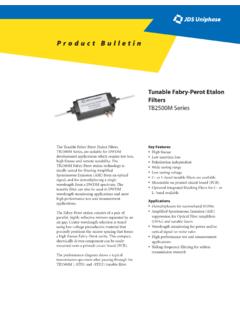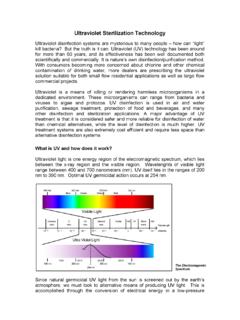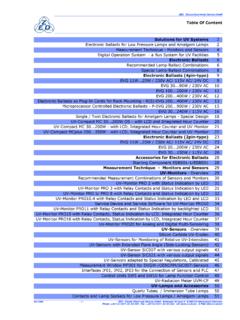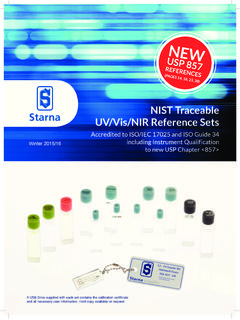Transcription of How Does UV Curing Work - Lightwavestore.com
1 Final Copy Ask the ESP Group: How does UV Curing work ? Materials that cure using ultraviolet light provide an extremely convenient cure on demand capability. Other compounds that harden, for example, at room temperature must be mixed and used within a certain time to obtain the best results. Typically there is no mixing required for UV- Curing materials, nor is there any requirement to use dispensed material within a short time period. Not only is this more convenient for the user, it also eliminates two potential sources of process variability meaning more consistent results!
2 In this document, we ll look at what ultraviolet light is, how it interacts with UV- Curing materials and different types of UV- Curing adhesives. What is UV light ? ultraviolet light is a particular portion of the light spectrum, typically considered to be in the wavelength range from 200 nm (nanometers) to 400 nm. light in this spectral range has many important uses including water purification, semiconductor lithography, sun tanning and, of course, adhesive Curing . [Spectrum graphic] Since ultraviolet light falls below the visible portion of the light spectrum, we cannot see pure UV light .
3 This can be an important consideration, because another significant property of light is its intensity. Special equipment a radiometer is required to measure the intensity of UV light . The intensity of light falling on a surface is measured in milliwatts per square centimeter (mW/cm2), or power (mW) per unit area (cm2). UV- Curing Adhesives Every high performance adhesive has at least two components to it. An obvious example is the two-part, room temperature Curing material already mentioned. A less obvious example would be contact cement, where only a single material is handled.
4 For this kind of adhesive to work , a solvent must evaporate from the product, leaving the actual bonding resin behind. So, the resin is one part and the solvent is the second part. In an ultraviolet - Curing adhesive, there are also two components. One part is the adhesive resin itself and the second part already mixed in is called a photoinitiator. The secret of the photoinitiator is that it will not react with the resin by itself. The photoinitiator must absorb ultraviolet light before anything can happen.
5 When the UV light is delivered, the photoinitiator will undergo a chemical reaction and produce by-products that cause the adhesive to harden. Previously, we said that UV light has two important characteristics wavelength and intensity. For the photoinitiator to react correctly, it must be exposed to light of the correct wavelength and of sufficient intensity. Otherwise, the chemical reaction will not Final Copy happen, or may not happen completely. The result will be poor or inconsistent adhesive performance.
6 Types of UV Adhesives There are a wide variety of UV- Curing materials available, for a broad range of applications. UV- Curing resins likely have been used to protect laminated flooring you are standing on, or to coat the peel and stick labels you use. For our purposes, we will look at two types of high performance, engineering adhesive typically used in product assembly. The first type of adhesive to become familiar with is an epoxy-based material. While some people use the term epoxy as a generic reference to all high performance, engineering adhesives, it has quite specific meaning within the adhesive world.
7 It is also different from other adhesive types, particularly the acrylic-based adhesives that we ll also look at. Epoxy adhesives use a catalytic cure mechanism. The catalyst is a by-product from the reaction of the photoinitiator to UV light . By definition, a catalyst is something that promotes a chemical reaction, but is not consumed in the reaction. One consequence of this is that UV- Curing epoxy adhesives can exhibit a shadow Curing capability material that is not directly exposed to UV light will or later.
8 Epoxy adhesives are also easy to modify for special purposes. For example, they can be filled with carbon, silver or gold to provide electrical conductivity. Other additives can enhance thermal conductivity, while maintaining electrical insulation. Additional performance properties of epoxy-based adhesives that can be modified include impact resistance, shrinkage, glass transition temperature, high temperature strength, surface-specific adhesion characteristics and chemical or moisture resistance. Acrylic adhesives result from an entirely different chemistry and a different type of photoiniator.
9 Curing of acrylic adhesives results from a free radical mechanism. The free radicals are produced by the photoinitiator when it is exposed to ultraviolet light . However, the free radicals are consumed in the adhesive cure process, so acrylic adhesives can only cure where UV light is delivered. At least one of the components being bonded must be UV-transparent to some degree. Another consequence of this cure mechanism is that no shadow cure capability is evident. Modification of properties in acrylic adhesives is more often conducted at the chemical level, through changes in formulation or combination with other base resins.
10 Wide ranging properties can include impact resistance, surface insensitivity, environmental resistance and others. The emergence of urethane acrylate adhesives, as well as acrylated epoxies, begins to make simplistic adhesive classifications more challenging. UV Cure Conditions Previous research has demonstrated that adjusting cure conditions can favorably impact the performance properties of many UV- Curing adhesives. Critical applications may require a sequence of Curing steps involving different intensities of light and duration of Final Copy exposure in order to optimize results.










